
この記事の内容は、SpringBoot が Jsp と Thymeleaf を統合する方法についてです。必要な方は参考にしていただければ幸いです。
この記事では主に、簡単なユーザーの追加、削除、変更、クエリのサンプル プロジェクトを実装するための SpringBootintegrationJsp と SpringBootintegrationThymeleaf について説明します。先に述べておくと、項目は 3 つあり、2 つは個別に統合され、1 つはすべてを統合します。これらのいずれかが必要な場合は、対応するセクションの概要を参照してください。プロジェクトのソース コードが必要な場合は、一番下に直接ジャンプし、リンクからプロジェクト コードをダウンロードできます。
環境要件
JDK: 1.7以降
SQL: MySql
ここでは、ユーザー情報を保存するためにmysqlにユーザーテーブルを作成する必要があります。
データベーススクリプトは次のとおりです:
CREATE TABLE `t_user` ( `id` int(11) NOT NULL AUTO_INCREMENT COMMENT '自增id', `name` varchar(10) DEFAULT NULL COMMENT '姓名', `age` int(2) DEFAULT NULL COMMENT '年龄', `password` varchar(24) NOT NULL COMMENT '密码', PRIMARY KEY (`id`) ) ENGINE=InnoDB AUTO_INCREMENT=17 DEFAULT CHARSET=utf8
新しいテーブルを作成したら、プロジェクトを作成しましょう。
私たちのプロジェクトは、Maven を通じて作成された通常の Web プロジェクトです。
プロジェクトを作成した後、対応するjarパッケージをダウンロードし、関連する開発を実行する必要があります。
これらの jar パッケージの場合、springBoot と Jsp に関連する jar を pom.xml ファイルに追加するだけです。
関連する注意事項が書かれているので、ここでは詳しく説明しません。
Maven の依存関係は次のとおりです:
<dependencies>
<!-- Spring Boot Web 依赖 核心 -->
<dependency>
<groupId>org.springframework.boot</groupId>
<artifactId>spring-boot-starter-web</artifactId>
</dependency>
<!-- Spring Boot 热部署 class文件之后会自动重启 -->
<dependency>
<groupId>org.springframework.boot</groupId>
<artifactId>spring-boot-devtools</artifactId>
<optional>true</optional>
</dependency>
<!-- Spring Boot Test 依赖 -->
<dependency>
<groupId>org.springframework.boot</groupId>
<artifactId>spring-boot-starter-test</artifactId>
<scope>test</scope>
</dependency>
<!-- Spring Boot JPA -->
<dependency>
<groupId>org.springframework.boot</groupId>
<artifactId>spring-boot-starter-data-jpa</artifactId>
</dependency>
<!-- Spring Boot Mybatis 依赖 -->
<dependency>
<groupId>org.mybatis.spring.boot</groupId>
<artifactId>mybatis-spring-boot-starter</artifactId>
<version>${mybatis-spring-boot}</version>
</dependency>
<dependency>
<groupId>mysql</groupId>
<artifactId>mysql-connector-java</artifactId>
</dependency>
<!--fastjson 相关jar -->
<dependency>
<groupId>com.alibaba</groupId>
<artifactId>fastjson</artifactId>
<version>${fastjson}</version>
</dependency>
<!--JSP 依赖 -->
<!-- servlet依赖. -->
<dependency>
<groupId>javax.servlet</groupId>
<artifactId>jstl</artifactId>
</dependency>
<dependency>
<groupId>javax.servlet</groupId>
<artifactId>javax.servlet-api</artifactId>
<scope>provided</scope>
</dependency>
<!-- tomcat的支持.-->
<dependency>
<groupId>org.apache.tomcat.embed</groupId>
<artifactId>tomcat-embed-jasper</artifactId>
<scope>provided</scope>
</dependency>
</dependencies> 関連する Jar パッケージをダウンロードした後、プロジェクトの構造を確認します。
まずはバックグラウンド関連のパッケージ説明:
src/main/java com.pancm.web - Controller 层 com.pancm.dao - 数据操作层 DAO com.pancm.pojo- 实体类 com.pancm.service - 业务逻辑层 Application - 应用启动类 src/main/resources application.properties - 应用配置文件,应用启动会自动读取配置
フロントエンド関連のファイルストレージ説明:
src/main/webapp WEB-INF - web.xml web相关的核心配置 WEB-INF/jsp - JSP文件的存放路径
プロジェクト全体構造図: 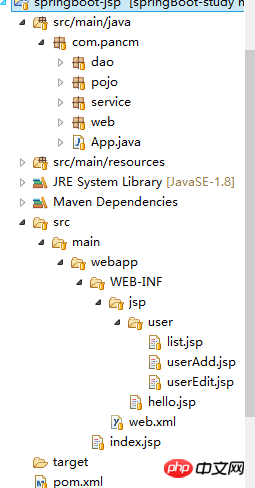
プロジェクト構造が確認できたら、対応する設定を追加していきます。
対応する設定をapplication.propertiesに追加するだけです。
データソースの構成は前のものと同様ですが、注意する必要があるのは、Jspの関連構成です。
springBoot のデフォルトでサポートされているテンプレートは Thymeleaf であるため、ここで対応する変更を加える必要があります。
構成は次のとおりです:
## 编码 banner.charset=UTF-8 server.tomcat.uri-encoding=UTF-8 spring.http.encoding.charset=UTF-8 spring.http.encoding.enabled=true spring.http.encoding.force=true spring.messages.encoding=UTF-8 ## 端口 server.port=8088 ## 数据源 spring.datasource.url=jdbc:mysql://localhost:3306/springBoot?useUnicode=true&characterEncoding=utf8 spring.datasource.username=root spring.datasource.password=123456 spring.datasource.driver-class-name=com.mysql.jdbc.Driver ## JSP配置 # 页面默认前缀 spring.mvc.view.prefix=/WEB-INF/jsp/ # 响应页面默认后缀 spring.mvc.view.suffix=.jsp
実際、ここでのコードは前の記事で説明したものと基本的に同じです。唯一の違いは、ここではデータベースの操作にJPAを使用していることです。ちなみに、JPA はこのフレームワークを使用しています)。
1つ目はエンティティクラスです。ここではJPAを使用しているため、以前のものとは少し異なり、いくつかのアノテーションが追加されています。
Entity: これがエンティティクラスであることを示します。
Table: このエンティティ クラスによってマップされるデータ テーブルの名前。
列: フィールドの属性を指定します。nullable は空でないかどうかを示し、unique は一意であるかどうかを示します。
すると、エンティティクラスのコードは以下のようになります。
@Entity
@Table(name = "t_user")
public class User {
/** 编号 */
@Id
@GeneratedValue
private Long id;
/** 姓名 */
@Column(nullable = false, unique = true)
private String name;
/** 密码*/
@Column(nullable = false)
private String password;
/** 年龄 */
@Column(nullable = false)
private Integer age;
//getter和setter略
} JPAを使用しているため、dao層はJpaRepositoryクラスを継承するだけでよく、エンティティクラスと主キーの型を指定する必要があります。
dao レイヤーのコードは次のとおりです:
@Mapper
public interface UserDao extends JpaRepository<User, Long>{
}ビジネスレイヤーは JPA を使用しますが、追加と変更には save を使用し、削除には findOne を使用して ID を渡す方法も非常に簡単です。 search、findAll はすべてをクエリするなどです。
サービスのコードは次のとおりです:
@Service
public class UserServiceImpl implements UserService {
@Autowired
private UserDao userDao;
@Override
public boolean addUser(User user) {
boolean flag=false;
try{
userDao.save(user);
flag=true;
}catch(Exception e){
System.out.println("新增失败!");
e.printStackTrace();
}
return flag;
}
@Override
public boolean updateUser(User user) {
boolean flag=false;
try{
userDao.save(user);
flag=true;
}catch(Exception e){
System.out.println("修改失败!");
e.printStackTrace();
}
return flag;
}
@Override
public boolean deleteUser(Long id) {
boolean flag=false;
try{
userDao.delete(id);
flag=true;
}catch(Exception e){
System.out.println("删除失败!");
e.printStackTrace();
}
return flag;
}
@Override
public User findUserById(Long id) {
return userDao.findOne(id);
}
@Override
public List<User> findAll() {
return userDao.findAll();
}
}コントロール層に関しては、ここでもJspが呼び出すためのインターフェースを提供しますが、このクラスのアノテーションは以前のRestControllerアノテーションを使用できません。データは json 形式で返されますが、返すときにインターフェースにジャンプする必要がある場合があるため、Controller アノテーションを使用する必要があります。メソッドで返したいデータ形式が json の場合は、メソッドに ResponseBody アノテーションを追加するだけです。
制御層のコードは次のとおりです:
@Controller
public class UserRestController {
@Autowired
private UserService userService;
@RequestMapping("/hello")
public String hello() {
return "hello";
}
@RequestMapping("/")
public String index() {
return "redirect:/list";
}
@RequestMapping("/list")
public String list(Model model) {
System.out.println("查询所有");
List<User> users=userService.findAll();
model.addAttribute("users", users);
return "user/list";
}
@RequestMapping("/toAdd")
public String toAdd() {
return "user/userAdd";
}
@RequestMapping("/add")
public String add(User user) {
userService.addUser(user);
return "redirect:/list";
}
@RequestMapping("/toEdit")
public String toEdit(Model model,Long id) {
User user=userService.findUserById(id);
model.addAttribute("user", user);
return "user/userEdit";
}
@RequestMapping("/edit")
public String edit(User user) {
userService.updateUser(user);
return "redirect:/list";
}
@RequestMapping("/toDelete")
public String delete(Long id) {
userService.deleteUser(id);
return "redirect:/list";
}
}バックエンド コードの紹介は以上です。フロントエンド JSP コードについては、これ以上は言いません (主な理由は次のとおりです)。インターフェイスが醜すぎます...)、プロジェクトを直接開始して効果を確認します。
プロジェクトを開始し、ブラウザで http://localhost:8088/list と入力します
メインインターフェイス: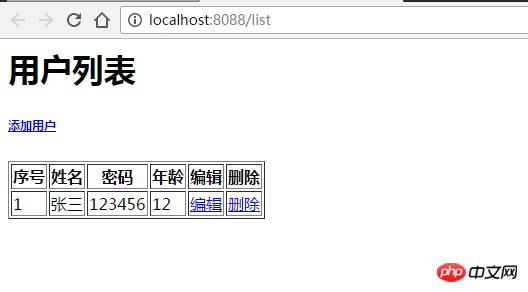
データを追加した後のインターフェイス:

その他の変更や削除も可能です実現するには、ここにマップを 1 つずつ配置する必要はありません。
springBoot 統合 Jsp はここにあります。
Thymeleaf は、Web および非 Web アプリケーションで使用できるテンプレート エンジンであり、XML/XHTML/HTML5、JavaScript、CSS、さらにはテキスト ファイルでも動作します。
私は Thymeleaf の使い方にあまり慣れていません。これはこの記事の主な内容ではありません。詳細については公式ドキュメントを確認してください。
https://www.thymeleaf.org/documentation.html
基本的に上記のSringBoot統合Jspと同じなので、ここでは詳しく説明しません。
由于SpringBoot默认的模版引擎就是Thymeleaf,所以Maven 依赖这块只需要在原先的springBoot项目添加Thymeleaf的依赖就行。
<dependency>
<groupId>org.springframework.boot</groupId>
<artifactId>spring-boot-starter-thymeleaf</artifactId>
</dependency>application.properties 配置这块,可以和之前的项目基本一致,需要注意的也只有spring.thymeleaf.cache配置,为false的时候是关闭Thymeleaf的缓存,更改界面之后会自动重启然后生效。
SringBoot整合Thymeleaf和SringBoot整合Jsp有个比较大的不同是,Thymeleaf的资源文件是放在src/main/resources目录下,Jsp的是放在src/main/webapp目录下。其中resources目录下的的static目录用于放置静态内容,比如css、js、jpg图片等。templates目录用于放置项目使用的页面模板,也就是.html文件。
它的项目结构图如下:
代码基本和SringBoot整合Jsp一致,这里就不在赘述了。
启动该项目,在浏览器输入:http://localhost:8085
主界面:
修改用户数据之后的: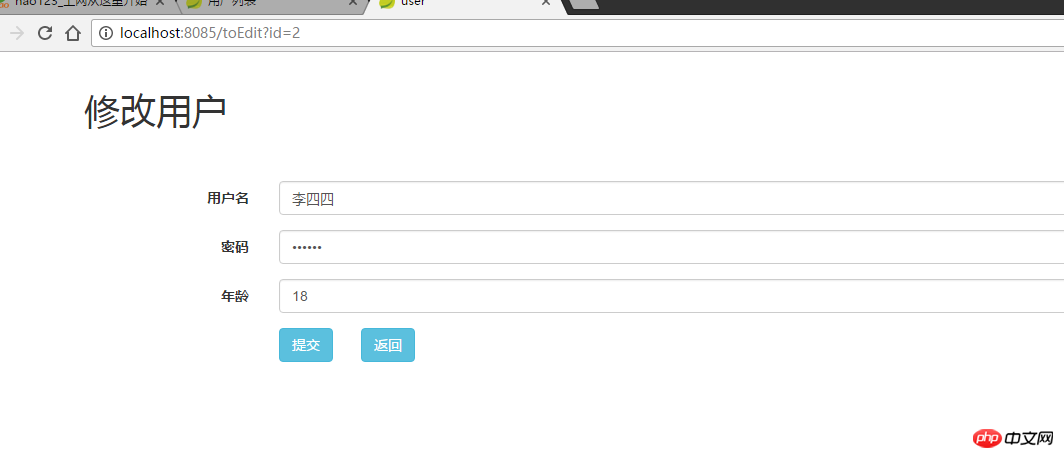
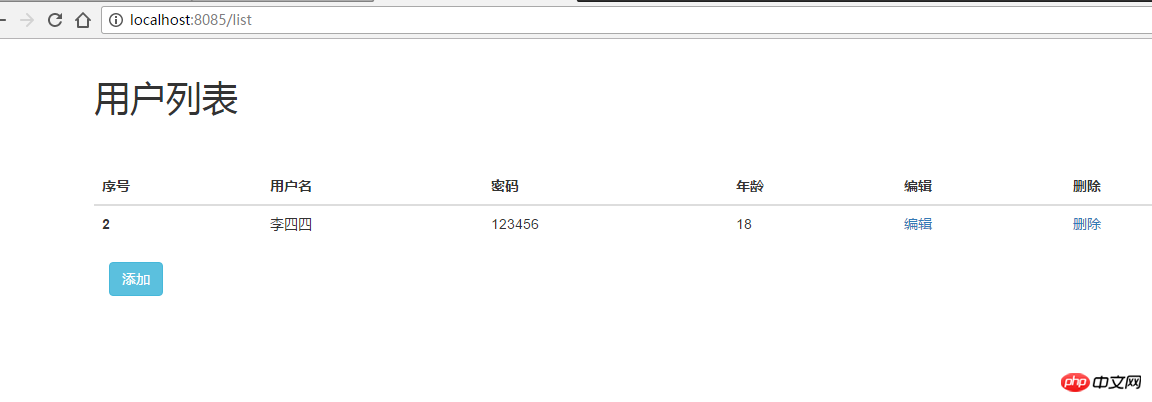
其它的功能也是可以实现的,这里就不再过多贴图了。
springBoot整合 Thymeleaf到这就结束了。
注:这个是后来新加的一个项目。
SpringBoot单独整合Jsp和Thymeleaf都还好,没出现什么问题。但是在一起之后,就有了改变,因为SpringBoot默认的模板引擎是Thymeleaf,加上JSP之后,JSP的模板引擎并不会生效。但是如果想用JSP模板,此时的禁用到Thymeleaf,虽然可以通过多态更改配置实现,但是感觉太过麻烦了。于是研究了一下,找到了共存的方法。
和前面来两个项目区别如下:
之前的Jsp和Thymeleaf配置都是在application.properties
文件中,这里我将它们的配置改到代码中获取。
2.之前Thymeleaf相关文件是放在 src/main/resources 目录下,这里移动到WEB-INF目录下,和之前的jsp文件夹同级。
3.增加一个控制层,严格区分访问Jsp和Thymeleaf的路径。访问Jsp的路径前缀加上jsp,访问Thymeleaf前缀加上templates。
那么新增的配置代码如下:
@Configuration
@EnableWebMvc
@ComponentScan
public class WebConfig extends WebMvcConfigurerAdapter {
@Bean
public ViewResolver viewResolver() {
InternalResourceViewResolver resolver = new InternalResourceViewResolver();
resolver.setPrefix("/WEB-INF/");
resolver.setSuffix(".jsp");
resolver.setViewNames("jsp/*");
resolver.setOrder(2);
return resolver;
}
@Bean
public ITemplateResolver templateResolver() {
SpringResourceTemplateResolver templateResolver = new SpringResourceTemplateResolver();
templateResolver.setTemplateMode("HTML5");
templateResolver.setPrefix("/WEB-INF/");
templateResolver.setSuffix(".html");
templateResolver.setCharacterEncoding("utf-8");
templateResolver.setCacheable(false);
return templateResolver;
}
@Bean
public SpringTemplateEngine templateEngine() {
SpringTemplateEngine templateEngine = new SpringTemplateEngine();
templateEngine.setTemplateResolver(templateResolver());
return templateEngine;
}
@Bean
public ThymeleafViewResolver viewResolverThymeLeaf() {
ThymeleafViewResolver viewResolver = new ThymeleafViewResolver();
viewResolver.setTemplateEngine(templateEngine());
viewResolver.setCharacterEncoding("utf-8");
viewResolver.setViewNames(new String[]{"thymeleaf/*"});
viewResolver.setOrder(1);
return viewResolver;
}
@Override
public void configureDefaultServletHandling(DefaultServletHandlerConfigurer configurer) {
configurer.enable();
}
@Override
public void addResourceHandlers(ResourceHandlerRegistry registry) {
super.addResourceHandlers(registry);
}
}项目的结构图如下: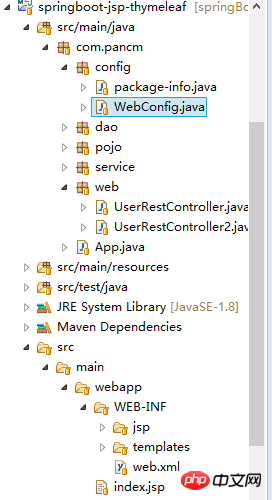
在浏览器输入:http://localhost:8089/list
查看Thymeleaf模板的界面
在浏览器输入:http://localhost:8089/list2
查看JSP模板的界面
可以看到已经成功整合。
关于SpringBoot整合Jsp和Thymeleaf 到这里就结束了。
SpringBoot整合Jsp的项目工程地址:
https://github.com/xuwujing/springBoot-study/tree/master/springboot-jsp-jpa
SpringBoot整合Thymeleaf的项目工程地址:
https://github.com/xuwujing/springBoot-study/tree/master/springboot-thymeleaf
SpringBoot整合Jsp和Thymeleaf的项目工程地址:
https://github.com/xuwujing/springBoot-study/tree/master/springboot-jsp-thymeleaf
相关推荐:
SpringBoot整合Netty并使用Protobuf进行数据传输的实现过程
以上がSpringBoot は Jsp と Thymeleaf をどのように統合しますか?の詳細内容です。詳細については、PHP 中国語 Web サイトの他の関連記事を参照してください。